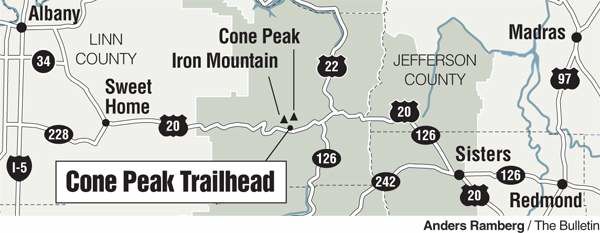Peak experience
Published 5:00 am Thursday, August 21, 2008

- Peak experience
Old-growth grandeur and alpine awe combine to make the Cone Peak Trail a different kind of day hike.
The wildflowers may be slightly past their peak, but the meadows leading to Cone Peak, west of the Cascades crest, are still a formidable destination. And you’ll enjoy the journey as well.
I parked at the pullout near milepost 64 on U.S. Highway 20, about a half-mile east of Tombstone Pass, and plunged down off the road onto a short nature trail that loops around an emerald meadow filled with elk scat and views of 5,455-foot Iron Mountain.
About halfway around the nature trail, there’s an old gravestone marking the final resting place of 18-year-old James A. McKnight, who died from an accidental gunshot wound in 1871. It was an unexpected discovery, and, given the age of the grave and its proximity to the Old Santiam Wagon Road, a fascinating one. Tombstone Pass: Go figure.
I followed the trail back to my parked car, crossed to the other side of the highway, and headed up the Cone Peak Trail, which switchbacks up the hill. For a while as I climbed, I could hear the cars whooshing by below, but the visual stimulation on this mountainside is a welcome distraction.
Besides the typical west-side understory — a riot of vine maple, ferns and other unidentified (by me) greenery — there are huge old-growth Douglas firs here and a rare stand of Alaska cedars that thrive at this aspect on this mountain and not too many other places in the state.
According to William L. Sullivan, author of several Oregon hiking guides, the ridge from Iron Mountain to Echo Mountain (including the Cone Peak area) is home to more types of trees (17) and 60 plant species deemed rare or unusual in the western Cascades.
The biological diversity made the switchbacks fly by in short order, and I found myself taking a breather in the first of several small meadows hemmed in by forest all around.
About two miles from the parking area, the trail enters the biggest meadow. All of a sudden, the forest opens up to spectacular views of Iron Mountain, Cone Peak, Echo Mountain and high, lonesome country in between.
According to the Cascadia Wildlands Project, the mountains hereabout are extinct volcanoes, the meadows strewn with cinder rock. The result is this dry meadow composed of shallow, nutritionally deficient soil, which is the ultimate medium for wildflowers of every stripe.
Cascadia estimates there are nearly 300 species of wildflowers that bloom here from spring through midsummer.
The big show has petered out, but several species remain in bloom.
This is the place to examine and photograph nearby Iron Mountain, which consists of twin volcanic peaks, one of which supports a fire lookout tower.
I turned around at the saddle, which made for a nice, 4-mile out-and-back hike. Another option is to continue on past the saddle and partway around Iron Mountain where you can take a side trail up to the peak (beware: there are some steep cliffs near the summit). Or you can take the Iron Mountain Trail back to the highway. Instead of walking the roadway, hikers can cross the highway and take the Santiam Wagon Road about a third of a mile to Tombstone Pass Sno-park. The Tombstone Nature Trail begins at the end of the parking lot. The Cone Peak Trailhead is about half-mile farther on.
Having been a victim of car clouting in the past, I was wary about parking along the well-traveled highway. The key seems to be to leave all valuables at home or carry them with you. I returned to find my vehicle undisturbed.
Parking is also available at Tombstone Pass, about one-third of a mile west.
If you go
Getting there: From Sisters, take U.S. Highway 20 west. The trailhead is 13 miles west of Santiam Pass near milepost 64. There’s a small turnout on the left. The Cone Peak Trailhead is across the highway. Or you can park at Tombstone Pass, one-third of a mile to the west.
Restrictions: No horses or mountain bikes are allowed on the Cone Peak Trail.
Contact: Willamette National Forest, 541-225-6300.






